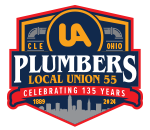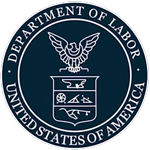PLUMBERS LOCAL 55 HISTORY
PLUMBERS LOCAL 55 HISTORY
Page Contents (Compiled by Union Histories)
The First 125 Years of United Association Plumbers Local No. 55
Even before the United Association of Journeyman Plumbers, Gas Fitters, Steam Fitters, and Steam Fitters’ Helpers of the United States and Canada – the “U.A.” – was established on October 11, 1889, to represent pipe-trades workers on an international level, the plumbers of Cleveland, Ohio, were organizing. While unionism in the pipe trades dates back to at least 1835, plumbers in Cleveland were acting collectively as early as 1874 – that year, they apparently held their first annual dinner-and-dance ball (as a 1891 invitation to the “17th Annual Ball of the Journeymen Plumbers’ Union No. 55” indicates) and picnic (as a July 1907 Cleveland Plain Dealer newspaper article announcing the local’s 33rd annual outing at Silver Lake implies).
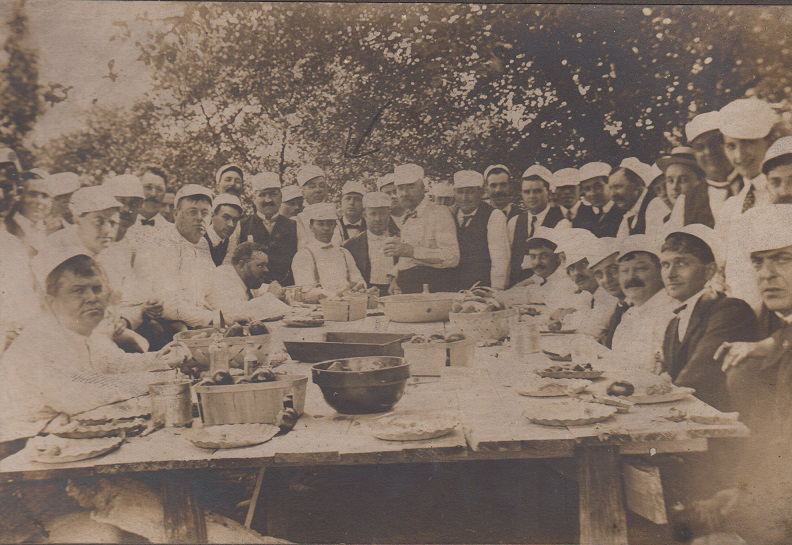
Indeed, as the official United Association History states, prior to 1889, organized plumbers, steamfitters and gas fitters were members of independent local unions with either no affiliation or affiliation with a variety of trades. But just 15 days after the U.A. was formed, Plumbers Local 55 of Cleveland was chartered by the fledgling International on October 26, 1889.
Soon after, the newly organized “Plumbers’ Protective Union” (to which the local was sometimes referred in reference to a former group that had organized plumbers in the city and around the country) held a meeting and secured a number of new members, according to an article in the May 3, 1890, Plain Dealer. “The new organization is moving upon a conservative basis and its members expect to receive their present pay for nine hours’ work very shortly,” the newspaper reported. “They assert confidently that no strike will occur this year.”
By February 1891, Local 55 was meeting every Friday evening in Room 6 at 356 Ontario Street. The local was also affiliated with the city’s Central Labor Union (C.L.U.) by that time.
Later that year, the local had dropped its membership in the C.L.U. but did march in the city’s Labor Day parade on September 7. The local also held that 17th yearly gala on November 17 at the Excelsior Hall on Erie Street.
In July 1892, Local 55 affiliated itself with the C.L.U. again, restarting what would be a long-lasting relationship, and by that time was meeting at 344 Ontario Street every Wednesday evening. By September that year, the local had 55 members, and in a report from the C.L.U. in the October 29 Cleveland Citizen newspaper, Local 55 “reported good trade.”
The local was also very active within the industry. For instance, as a letter from Local 55 in the October 1892 Journal announced, the local was “working hard” to have the State Legislature pass a bill requiring that only “practical plumbers” be employed as plumbing inspectors in cities with a population of 60,000 or more – which would include Cleveland.
Making Great Progress
By most accounts, work for Local 55 during its first decade was steady, although there were some periods during which is was very slack. Regardless, the local stayed active on many fronts; most notably, it continued to push its bill in the State Legislature for oversight of plumbing inspections and in early 1893 held a conference with the Master Plumbers’ Association to secure its support for the legislation.
Membership also gradually increased through those first years. By 1897, the local had 164 members at one point, and in September 1899 the local was representing over 220 plumbers in the Greater Cleveland area.
In that setting, U.A. General Organizer Thomas E. Burke was able to declare in the December 1899 Journal that Local 55 was “making great progress.”
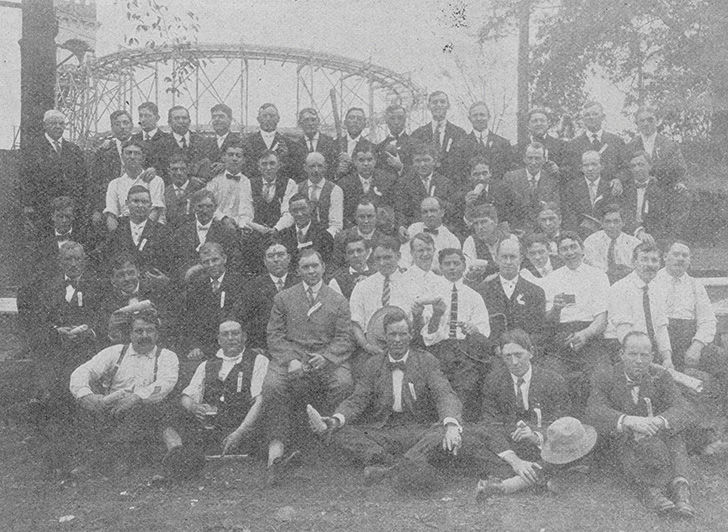
The local also apparently embraced its early evolution and in late 1899 raised its dues from 20 cents to 30 cents per week in an effort to secure its immediate financial future – without the help of the U.A., if necessary. Questioning the International’s lack of fiscal support for its locals, Local 55 correspondent Laurin W. Tilden even wrote in the January 1900 Journal, “This last raise in No. 55’s dues is pretty clear evidence of our ideas of support. This act also says (between the lines) if the U. A. won’t give us the support and backing we want and give it to us all and by the broad and combined or substantial method, we will tackle the job on our own hook.”
Also protecting its individual member, Local 55 on April 2, 1900, went on a prolonged strike after failing to arrive at an agreement with its employers, from whom the local was asking for a raise in wages to $1.50 per day. Local 55 President Frank Poplowsky described and explained the strike, during which 247 members were out for 33 days, in the May 1900 Journal:
“A motion for a general strike was put and resulted in 178 in favor and 5 opposed. A strike committee was appointed, the city districted, pickets appointed, daily meetings held, and every one registered daily or gave a good reason for not doing so. …
“The pickets, and in fact every one that had anything to do, were as busy as bees. This activity of the pickets in many cases wore off, however, after a few days more, because they were discouraged at not finding any scabs or anything else with which to busy themselves. …
“… we offered a compromise of 25 cents on the wages … they refused our offer. No. 55 was equal to the job, however, and immediately started nine shops, employing 29 men. To cut a long story short, we compromised on the wages – accepted a 25-cent raise. The rules were altered slightly, for the better, if anything we all agreed to be good ….
Times were tough for Local 55 immediately following the strike, as in its wake several shops went nonunion and there was little work in the area. But “the officers and members never became discouraged” and by April 1901 the local was “in a nourishing condition,” according to the April 1901 Journal.
While conditions for the local waffled between “poor” and “fair” for much of the following few years, with plumbers making $4 a day in 1904 and 1905, by late 1907 Local 55 had made Cleveland an “entirely closed town” and “improved the financial condition of its local treasury to such an extent that the creating of (the) office of general secretary of Local No. 55 has been very profitable to the local,” U.A. General Organizer E.W. Leonard reported in the December 1907 Journal.
By September 1909, Local 55 was able to successfully establish a minimum wage rate of $5 for an eight-hour workday. The ongoing progress compelled U.A. General Organizer John J. Casey to proclaim in the Journal that month:
“This demonstrates that Local 55 is living up to its reputation of being one of our militant progressive locals.”
Being Torn Asunder
The growth and development of Local 55 continued throughout the next decade, with the local’s membership surpassing 300 plumbers in 1913. Its members also worked on some of the more prestigious projects in the area during those years, including the Hotel Cleveland in 1918, where 60 members represented “the greatest number of men to be employed continuously on any job in the City of Cleveland,” the local’s Pete Burke boasted in the June 1918 Journal.
Seeking to raise wages from $8 to $12 per day, the local again went on strike on June 1, 1920, for two weeks before settling for $11. What’s more, when the members returned to work under the new rate, all nonunion plumbers, who had been imported to the city during the strike, were discharged and the union-shop conditions that existed prior to the strike were returned in the city, according to the September 1920 Journal.
The following year, a building-trades-wide lockout over a wage reduction began in Cleveland and would last into March 1922, but the plumbers were not affected because they were under contract. When their agreement expired, however, they were forced to take a cut in early 1923 to $10.50 per day – although the local and its employers reached an agreement again in spring 1924 that returned the scale to $11.
Meanwhile, Local 55’s roster expanded to over 700 plumbers and apprentices that year and would continue to grow throughout the remainder of the decade.
In particular, the local and its territory expanded when Plumbers and Steamfitters Local 321 of Painesville and Willoughby, Ohio, was merged into Local 55 and Steamfitters Local 120 of Cleveland on May 16, 1928. At the heart of the merger was the dwindling membership of Local 321, which had been chartered May 14, 1923 – but by the time of the amalgamation, it had only 13 members.
At the onset of the Great Depression in 1929, working conditions for Local 55’s members had gradually deteriorated. In fact, U.A. General Organizer William Lynn met several times with the Cleveland Master Plumbers’ Association to discuss what he called “the deplorable conditions that are confronting the members of our local unions in that city, particularly in the plumbing branch of the industry” in the March 1929 Journal.
He also noted that Local 55 was “infested with a very dangerous condition” and was “being torn asunder” by the formation of clubs within the local. These clique-like factions would often criticize if not outright undermine the authority and decisions of the local’s officers.
Throughout the 1930s and the remainder of the Great Depression, membership in Local 55 constantly fluctuated with the unstable times. Reaching 758 members in June 1931, membership dropped to 634 in June 1935 before rising again and then dipping to 605 in June 1940.
During those years, the local also often found itself in jurisdictional disputes with other building trades, including the International Brotherhood of Electrical Workers and U.A. Steamfitters Local 120 and the sprinklerfitters of Cleveland. In one particular episode in 1941, Local 55 squared off with the iron workers over the installation of piping from a coal hopper and pulverizer that were under construction in the city.
Advancing Their Cause
During World War II, Local 55’s members contributed to the war effort while working in places such as a Republic Steel construction project and the Plum Brook ordnance plant. The plumbers, like most tradesmen, worked for war-time salaries applied by the Wage Adjustment Board under a wage-stabilization agreement.
On February 15, 1943, however, 113 members of the Local 55 auxiliary who were employed in the Maintenance Division of the City of Cleveland Waterworks Department went on strike for higher wages and would be out through April. The water servicemen were being paid $1,992 per year and were asking for $2,400, but the city only offered an annual wage increase of $108, according to the April 17, 1943, Plain Dealer. In the end, the Local 55 members agreed to submit their grievances to the War Labor Board for a decision at a later date so that they could return to work.
Less than a year after the war ended, the local’s 800 plumbers threatened to strike in July 1946 while demanding a 15-cent an hour wage increase. A work stoppage was postponed and avoided as additional negotiations with employers of the Master Plumbers’ Association took place, the July 20, 1946, Plain Dealer reported.
By 1947, Local 55 and its sister Northeast Ohio locals 120, 655 and 669 were making plans for setting up a District Council in Cleveland and the vicinity. Final plans were made in February that year, and Local 55 Brother John Roddy was elected the Council’s first secretary.
In accordance with new U.A. policy, a chartered was issued on January 31, 1947, to the Metal Trades Division of Local 55. Also on that day, the U.A. cleared members of the former Marine Pipe Fitters Local 655 into locals 55 and 120.
The next year, another group of workers in the local’s auxiliary was granted raises of 14- and 12-cents an hour under a contract retroactive to August 22, 1948, and good until October 15, 1949. With the new agreement, the local’s 80 members working in wholesale plumbing supply houses around Greater Cleveland returned to work on October 18, 1948, following the settlement of a two-week-old strike that affected 22 supply businesses.
Also during the late 1940s, Local 55 moved into a new union hall and office headquarters at 2403 Payne Avenue in late 1947, where it would remain until relocating again in 1961. The local had previously been located at 1651 East 24th Street since 1942.

Though not the first local in the United Association to have hospitalization and pension plans for its members, Local 55 was one of the early pioneers in providing these benefits when it created its Health and Welfare Fund in May 1952. The fund was initially subsidized by employers’ payments of 3 cents per hour worked by each member, which was raised the following year to 10 cents per hour.
Three years later, Local 55 received a new two-year contract on May 10, 1955, providing for a 15-cent-an-hour package of 7-1/2-cent raises for each of the next two years. The increase raised the union’s 1955 wage scale to $3.40 an hour.
A labor dispute in the Building Trades in 1958 affected Local 55 and its plumbing contractors in the Association of Plumbing Contractors, as both had committed their organizations to abide by the negotiations of a Policy Committee composed of the Cleveland Building Trades Council, the Building Trades Employees’ Association and Associated General Contractors (A.G.C.). When one local union refused to accept any rate set by the Policy Committee, the A.G.C. contractors and the Home Builders shut down a majority of building work in the city as negotiations continued, according to the August 1958 Journal.
The dispute lasted six weeks before an agreement was reached on wages, and all building tradesmen returned to work on a three-year agreement. Afterwards, Local 55 was denied lock-out benefits during the dispute because the local had not been negotiating with its contractors and was committed to the wages set by the Policy Committee.
Success Among Racism Charge
Another new decade began with great promise when the Local 55 Health and Welfare Fund reached a milestone in July 1960 when it paid for hospital and surgical bills for member James Gilmore, who had undergone an open-heart operation. With the payment, the fund had compensated more than $1 million in benefits to plumbing industry employees and their dependents since 1953; in its first eight years of existence, the fund had paid more than 7,700 claims.
That year, the local also started its Pension Plan for members.
Members were working on the new Veteran’s Hospital in Cleveland under C. P. Wright and Company by 1962 – but not without some difficulty. Pre-cut hanger rods were being shipped to the job for plumbers to use, but the union felt that the rods should be cut on the job by members of Local 55, in accordance with the U.A. Constitution.
The contractor informed the foreman that any plumber who did not use pre-cut rods would be discharged, according to the June 1962 Journal, and at one point even attempted to lay off two plumbers before the remaining 22 plumbers refused to work unless the pair was reinstated.
A temporary agreement was reached to avert a work stoppage, and eventually, contractors on a Joint Board Committee agreed that C. P. Wright was in violation of the agreement between the contractors and Local 55 and instructed the contractor to have hanger rods cut by the local’s members.
Citing a lack of job opportunities and security, Plumbers and Steamfitters Local 713 of Ashtabula merged with Local 55 and Local 120 on March 1, 1963. The local had been chartered by the U.A. on November 29, 1919.
But when William R. Baker Jr. and Theodius Hilliard Jr., two non-union “negro” journeymen plumbers, reported to work on July 23, 1963, at the convention center being constructed at the mall in Cleveland, 15 members of Plumbers Local 55, 30 members of Pipe Fitters Local 120 and 10 union asbestos workers walked off the job. While Local 55 and its members claimed the walkout took place because Baker and Hilliard were not union men, public charges of racism were leveled at the local – essentially igniting a decade-long battle for the local to integrate minorities into the trade while staving off accusations of discrimination.
A week before the walkout, the City of Cleveland had entered into an agreement with the United Freedom Movement, a civil rights organization seeking to put more black craftsmen to work on the convention center project. Plumbing contractor Smith & Oby Company soon after hired the black journeymen, but one week later on July 29, Local 55 took a “holiday” on construction projects around the city in protest of the hiring of the non-union men.
On August 1, Local 55 and Smith & Oby asked Baker and Hilliard to apply to the local as apprentices, according to the Plain Dealer newspaper. Three days later, Local 55 reached an agreement with the United Freedom Movement allowing black plumbing contractors to sign up with the union and their employees to be admitted into the union after passing an examination, the August 6 Plain Dealer reported. It also provided the two non-union black plumbers with the chance to work on the project as journeymen after a black plumbing contractor was selected to work on part of it.
Frank Evans, a labor consultant for United Freedom, said in the Plain Dealer that the deal was “the best agreement reached yet in the United States on the question of acceptance of Negroes into craft unions.”
Local 55 continued making headway through the Sixties when in April 1964 it reached an agreement with the Plumbing Contractors’ Association on a new three-year labor pact that included a total 95-cent hourly increase over the duration of the contract.
Then on November 4, 1965, Local 55 dedicated its new union hall and office building at 1720 East 30th Street with a gala event. The local would remain at that location until moving to its current headquarters in 1996.
The next year, Local 55 and the Plumbers Joint Apprenticeship committee were found innocent of violating Ohio civil rights laws after having been accused by the Ohio Civil Rights Commission of requiring photographs of applicants for the apprenticeship program. The commission charged that in doing so, the local was discriminating against black applicants, while the local and apprenticeship committee said the photographs were needed for identification purposes; ultimately, a hearing examiner for the commission ruled that there was no evidence to support charges of discrimination.
While in 1966 racial-discrimination charges were still being leveled at Cleveland building and construction trades unions and were being investigated by the U.S. Defense Department, Local 55 was again at the forefront of bringing minorities into the trades. For instance, at an April 27 meeting that year meant to “bring Negro contractors, most of whom are nonunion, together with union officials of the construction trades,” only officials of Local 55 were in attendance, according to the April 28 Plain Dealer.
What’s more, the only black plumbing contractor at the meeting was William McKennie – who already had a contract with Local 55 and employed two black plumbers who were members of the local, the newspaper reported.
The local was again investigated for alleged racial discrimination in August 1967 by the U.S. Justice Department after the local locked its union hall to members of the Cleveland Plumbing Contractors Association after it had taken 45 blacks to apply for apprenticeship, the Plain Dealer reported on August 9. But the following year on February 23, four blacks were among 26 to be certified as apprentices for the Joint Apprenticeship Committee of Local 55.
Meanwhile, 27 black young men had passed examinations and joined 175 white applicants on a list of qualified apprenticeship applicants, according to the February 24, 1968, Plain Dealer. Joint Apprenticeship Committee Chairman Frank J. McHale also announced that the building and construction trades “were inviting minority groups to join the construction industry.”
The local and the Plumbing Contractors’ Association reached an unprecedented wage settlement on April 28, 1967, in which the $2.27-an-hour increase in wages over the three-year contract was “the highest ever negotiated by a building trade union in Cleveland,” according to the Plain Dealer. The 40-percent increase over three years eventually raised union plumbers’ pay to $7.71 an hour, including fringe benefits, by May 1, 1969.
Another “first” in the contract made Local 55 an exclusive hiring hall, and the agreement further included various improvements to working conditions for the local’s 1,700 members.
Then on November 4, 1965, Local 55 dedicated its new union hall and office building at 1720 East 30th Street with a gala event. The local would remain at that location until moving to its current headquarters in 1996.
The next year, Local 55 and the Plumbers Joint Apprenticeship committee were found innocent of violating Ohio civil rights laws after having been accused by the Ohio Civil Rights Commission of requiring photographs of applicants for the apprenticeship program. The commission charged that in doing so, the local was discriminating against black applicants, while the local and apprenticeship committee said the photographs were needed for identification purposes; ultimately, a hearing examiner for the commission ruled that there was no evidence to support charges of discrimination.
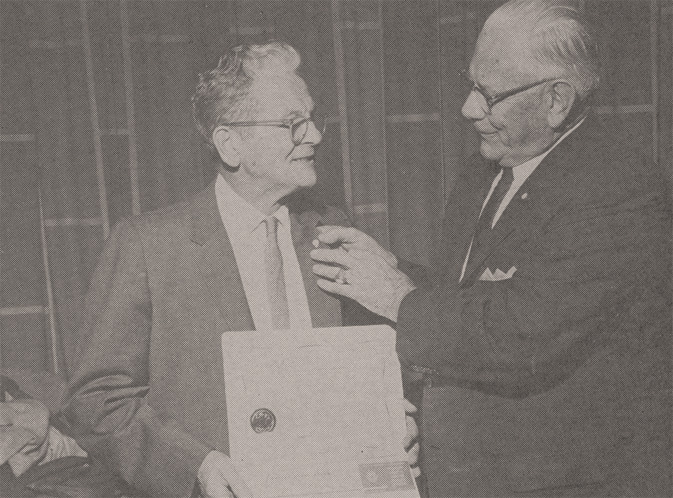
While in 1966 racial-discrimination charges were still being leveled at Cleveland building and construction trades unions and were being investigated by the U.S. Defense Department, Local 55 was again at the forefront of bringing minorities into the trades. For instance, at an April 27 meeting that year meant to “bring Negro contractors, most of whom are nonunion, together with union officials of the construction trades,” only officials of Local 55 were in attendance, according to the April 28 Plain Dealer.
What’s more, the only black plumbing contractor at the meeting was William McKennie – who already had a contract with Local 55 and employed two black plumbers who were members of the local, the newspaper reported.
The local was again investigated for alleged racial discrimination in August 1967 by the U.S. Justice Department after the local locked its union hall to members of the Cleveland Plumbing Contractors Association after it had taken 45 blacks to apply for apprenticeship, the Plain Dealer reported on August 9. But the following year on February 23, four blacks were among 26 to be certified as apprentices for the Joint Apprenticeship Committee of Local 55.
Meanwhile, 27 black young men had passed examinations and joined 175 white applicants on a list of qualified apprenticeship applicants, according to the February 24, 1968, Plain Dealer. Joint Apprenticeship Committee Chairman Frank J. McHale also announced that the building and construction trades “were inviting minority groups to join the construction industry.”
The local and the Plumbing Contractors’ Association reached an unprecedented wage settlement on April 28, 1967, in which the $2.27-an-hour increase in wages over the three-year contract was “the highest ever negotiated by a building trade union in Cleveland,” according to the Plain Dealer. The 40-percent increase over three years eventually raised union plumbers’ pay to $7.71 an hour, including fringe benefits, by May 1, 1969.
Another “first” in the contract made Local 55 an exclusive hiring hall, and the agreement further included various improvements to working conditions for the local’s 1,700 members.
Protecting Their Trade
With a staggering construction slump hitting the nation and causing a job shortage in the Cleveland area in the early 1970s, up to 30 percent of the local’s members were not working in early 1971. The situation even forced the local to seek jobs for its members with other locals across the country.
Then on May 1, 1970, Local 55’s 1,200 plumbers joined 1,600 pipefitters in Cleveland in a strike for higher wages and to protest a Greater Cleveland contractors’ proposal that would require each local to hire 400 minority group members over the next five years. The unions opposed the plan because it would “undermine job security for the tradesmen,” the Cleveland Press reported on May 8.
At the time, the locals were voluntarily working on a plan to incorporate minority group members into their trades. Business Manager Richard Cleary even told the Press that Local 55 was at one time “the second highest in Cleveland of all the building trades with minority group practices.”
The strike trudged on, however, for over three months, bringing an estimated $600 million in construction projects in Greater Cleveland to a standstill, according to the June 4, 1970, Plain Dealer. Among the jobs was an estimated $2 million in home and apartment house construction and $400 million in commercial development, including an addition to the Cleveland Trust Company building, the science center at Case Western Reserve University, and additions to the Cleveland Museum of Art, Cleveland State University and Metro General Hospital.
The strike ended August 9 when Local 55 ratified a three-year contract that gave its plumbers a $3-an-hour raise into 1973, bringing their pay to $10.81 an hour, and also dealt with work rules, hiring procedures and apprenticeship program improvements. The contract also included an intensive affirmative-action program for hiring more apprentices and workers from minority groups – which the August 10 Plain Dealer called “a key issue in the negotiations.”
The minority recruiting program, which nationally was attempting to train 500 blacks and other minorities for the pipefitting and plumbing industry, was sponsored by the United Association, the National Contractors Association and the U.S. Department of Labor.
The local ratified a new, one-year contract with the Contractors’ Association on April 21, 1973, that gave members a 30-cent-an-hour raise. The agreement took their rate to $9.53 an hour on May 1 after the present contract expired April 30.
By the end of that decade, the local put a new Supplemental Unemployment Benefit Fund into effect on August 6, 1979. With a new agreement in July, employers were contributing 20 cents an hour to the fund as part of the wage and benefit package.
The local was representing over 1,500 journeymen and apprentices at the dawning of the 1980s. However, conditions that were changing locally and nationally diluted the strength of organized labor during that time period, and the local’s membership slowly dwindled – hovering just above 1,200 for the entire second half of the decade.
Sadly, the local’s recording secretary, Thomas McIntyre, was shot and killed in Cleveland’s Flats area in March 1980. Committed to obtaining justice for its fallen brother, the local offered a $10,000 reward for information leading to the arrest and conviction of the killer.
Among the major projects on which the local worked during the ‘80s was a 5-year, multimillion dollar renovation project of the Stouffers Inn on the Square in downtown Cleveland beginning in 1986.
Serving as ‘A Foundation’
“Just as the materials of plumbing have changed over the past 100 years, so has the composition of our membership. Today, Local 55 can probably claim it represents men and women of all races and religions while they perform the duties of their honorable trade for just compensation.”
(Excerpt from the Plumbers Local 55 100-Year Anniversary Program)
At 100 years old in 1989, Local 55 represented 1,275 diverse members. That year, nearly 1,400 members, their wives and guests, contractors, political leaders and labor officials from other unions gathered at the Stouffers Inn on October 20 to celebrate the local’s first century.
The local’s pension fund began participating in a building-trades program offering funding for projects in the Cleveland region beginning in 1990. The funds could provide some $75 million in new money to finance building projects of a major scale, the Plain Dealer reported in its December 7 issue.
During the late 1980s and early 1990s, with the City of Cleveland’s downtown region beginning to be revitalized, Local 55 participated in the construction of many major projects in the city’s ongoing rebuilding process. As a December 1993 Journal article detailing the U.A.’s contributions to the renaissance stated, “It is the work of Plumbers Local 55 and Pipefitters Local 120 which serves as a foundation for community growth and prosperity.”
Among the key projects on which Local 55 members worked was the $392 million Gateway Stadium and Sports Complex in downtown Cleveland, which received the largest plumbing permit ever issued in the city, according to the Journal. Gateway includes the 41,000-seat Jacobs Field (now known as Progressive Field) baseball stadium, which opened on April 4, 1994; and the 21,000-seat Gund Arena (now known as Quicken Loans Arena), which opened on October 17, 1994.
Notably, all of the bathroom fixtures for Gateway were pre-fabricated off-site by U.A. plumbers and brought to the jobsite in modules to save labor and installation time, the Journal explained.
Local 55 members played prominent roles in the construction of the state-of-the-art, $200 million printing and distribution center for the Plain Dealer and the new Concourse “D” at Cleveland Hopkins International Airport. The local also helped make “the single largest piping job in Cleveland in the previous 20 years” a reality, working with Local 120 at LTV’s Cleveland Steelworks beginning in May 1992 to get its continuous casting facility up and running in early September 1993.
That year, Local 55 and its contractors from the Cleveland Plumbing Industry (C.P.I.) Fund were among the first organizations in the country to begin mass qualifying their medical gas installers in accordance with new requirements of the National Fire Protection Association, according to the Journal. In June 1993, 75 Local 55 plumbers representing 18 C.P.I. contractors took a comprehensive test on a brazing procedure designed especially for medical gas-line installation.
The local then moved into its current union offices and hall at 980 Keynote Circle in Brooklyn Heights in 1996. Attached to the building is the local’s J.A.T.C. training facility.
Additional projects on which Local 55 plumbers worked at the close of the millennium included a new Intercontinental All-Suites Hotel on the Cleveland Clinic campus, built to serve as lodging for the families of patients at the clinic. The project was started in the fall of 1998 and was completed the following summer with Northern Ohio Plumbing performing the plumbing work.
The Cleveland Browns of the National Football League broke ground on a new stadium on May 15, 1997, and with the work of Local 55 plumbers, the new, $283 million Cleveland Browns Stadium (now called FirstEnergy Stadium) opened on September 12, 1999.
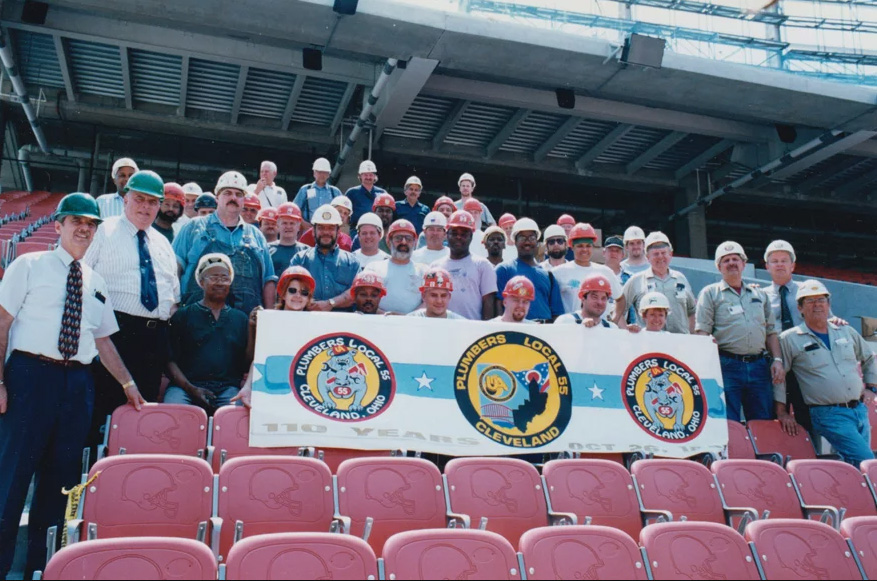
Building Towards the Future
A new millennium brought many new milestones and challenges for Local 55; most notably, the local’s craftsmen remained a vital part of the City of Cleveland’s continuing revival. An article in the August 2007 Journal even commented, “With the help of its strong relationship with its signatory contractors … and the Cleveland Plumbing Contractors Association, (Local 55) is helping Cleveland rebound and become a vibrant city that everyone can love.”
Central to the city’s resurgence was its position as home to some of the most-well respected medical institutions in the world, such as the Cleveland Clinic, Rainbow Babies and Children’s Hospital and University Hospitals. Local 55 members worked at all of these facilities and many more over the years, including three projects with the Cleveland Clinic and University Hospitals completed soon after Y2K.
In 2000, a team of plumbers was involved in constructing a new building to expand the cancer treatment capabilities of the Cleveland Clinic The plumbing contractor on the new, $50 million, 160,000-square foot facility, which was completed in summer 2000, was Gorman-Lavelle.
(John I. Gorman appeared on the first Local 55 membership list, and Michael D. Lavelle was listed as a delegate to the 1921 U.A. convention. The two plumbers later formed the Gorman-Lavelle Corporation in 1926, and although John passed away later that year, Mike still presides as patriarch over the company.)
Local 55 Business Manager Jim Sullivan credited the U.A. Medical Gas Certification Program with helping to put Local 55 members and other U.A. tradespeople on hospital projects around Cleveland.
The local also worked on the multi-building project for Progressive Auto Insurance Company’s new headquarters in Cleveland, which was completed in 2000 with Feldman Mechanical performing the plumbing work. “The U.A. workers on this project excelled in this fast-track, under-budget project,” Gregg Gresko of contractor Marlin Mechanical remarked in the February 2000 Journal.
Also in the early 2000s, Local 55 was involved in the largest public-housing retrofit project in the country with Coleman Spohn, a $36 million “green” project for the Cuyahoga Metropolitan Housing Authority.
By 2007, Local 55 had up to 175 journeymen concentrating on the residential-service side of the plumbing industry. But members continued to service all aspects of the industry and staff a wide variety of construction work, including multiple Cleveland Public Schools System projects.
Additional varied projects have included the $480 million Crocker Park mixed-use residential and retail development completed in 2005 under Neptune Plumbing and Heating Company; the Cleveland Clinic Glickman Tower and Glickman Urological and Kidney Institute completed in 2008 under Gorman-Lavelle; and plumbing work throughout Case Western Reserve University’s animal resource center
As Local 55 celebrates its 125th year, the local is as strong as ever with a membership of 1,200 plumbers, who recently completed work on some of the most prominent projects in northeast Ohio, including Earnst & Young’s new world headquarters building, the Cleveland Browns Stadium remodel, Cuyahoga County headquarters and the Horseshoe Casino at the Terminal Tower. The local’s future looks bright, too – in the approaching years alone, the local’s members are working on many more of the area’s important construction jobs, such as the revitalization of the East Bank of Cleveland’s Flats area, American Greetings’ new world headquarters, the Hilton Hotel in downtown Cleveland and the Cleveland Clinic Cancer Center.
At the Forefront of Training
A clause first introduced in 1910 into the United Association Constitution urged plumbing locals to “use their best efforts and endeavor to regulate all helpers and apprentices until such time as local unions are otherwise advised by a convention on one or more referendum votes.” According to The Rise of the United Association, a book by Martin Segal, locals’ policies toward apprenticeship up to and through the early 1920s varied; in some cities, the plumbers locals and the employers’ associations jointly operated training programs “that produced highly qualified journeymen.”
Plumbers Local 55 actually started an apprenticeship training program in 1917, holding day classes at the Cleveland Public Schools’ Waring and Oakwood schools. Segal went on to write specifically about the unique apprenticeship system that was then established in Cleveland in 1922:
“The Cleveland program was governed by the rules of a ‘joint agreement’ between Local 55 and the Associated Plumbing Contractors of Cleveland and was administered by a joint committee of the two organizations. The apprentices were chosen by the master plumbers but were, in effect, indentured to the Joint Apprenticeship Committee rather than to an employer.
“The number of apprentices allowed in any one shop depended on the number of journeymen employed; the maximum was three apprentices per shop.
“The term of apprenticeship lasted four years, with the pay rising from 25 percent of a journeyman’s wage in the first year to 50 percent of this wage in the fourth year.”
The Cleveland Building Trades Apprentice School, of which the plumbers’ apprentice training was a part, held its first annual commencement on April 10, 1925, in the East Technical High School auditorium at East 55th Street and Scovill Avenue. The Apprentice School was being conducted by the Cleveland Board of Education in co-operation with several building trades groups, including Plumbers Local 55 and the Associated Plumbing Contractors.
The school’s General Committee on Apprentice Training included representatives from the Plumbers’ Joint Apprenticeship Committee: Local 55 member Lewis Sloat and Ed Bohm, secretary of the Associated Plumbing Contractors.
From 1926 to 1957, the apprentices were taught at the Cleveland Trade School, which is more commonly referred to as the “Eagle Avenue Trade School.” Through organized labor’s efforts, the Max S. Hayes Vocational School was built by the Cleveland Board of Education and opened in 1957. Most of the building trades, including the plumbers, began holding their apprentice classes there.
As Local 55 celebrates its 125th year, its Joint Apprenticeship and Training Committee (J.A.T.C.) is providing three types of training programs and journeymen upgrade training in a state-of-the-art, 18,000-square-foot facility attached to the local’s office building. Apprenticeship is a 5-year program consisting of 1,000 hours of instruction and 8,500 hours of on-the-job training, during which apprentices are paid to learn a plumbing career with escalating wages each year.
Training, certifications and qualifications offered by the Local 55 J.A.T.C. and Cleveland Plumbing Contractors’ Association include OSHA 10 and 30 Certifications; Confined Space Qualification; Trench and Excavation Qualification; First Aid and CPR; Welding; Foreman Certification; Green Plumbing Qualification; Medical Gas Certifications; and City of Cleveland Plumbers Qualification.
